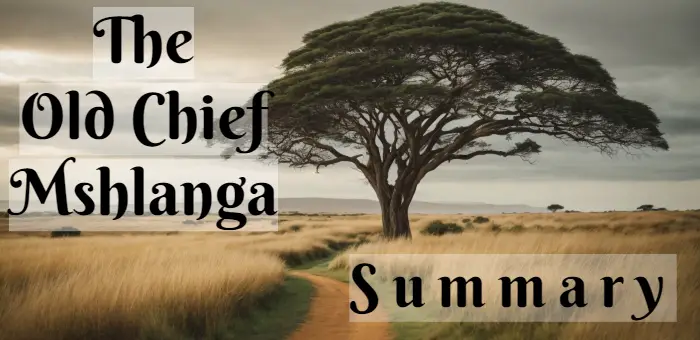“The Old Chief Mshlanga” Summary
The narrator has grown up on her father’s farm, which, like all white farms, is mostly uncultivated. They have black servant who leave after a season, replaced by others next season. Some go to the gold mines in Johannesburg in search of better pay.
She takes the servants for granted. She’s called “Nkosikaas”, meaning Chieftainess, by them and even by black children her own age. White children will have dogs chase natives or tease them without any guilt.
When she’s a bit older, she walks the land outside the farm with a gun and two dogs; she never feels afraid. The dogs chase the natives up a tree when they meet on a path. Her mother doesn’t want her talking to the servants. They’ll laugh at the servant’s English. These things cause certain questions to rise in the girl’s mind.

One evening when the narrator is fourteen, she’s out walking along a mealie field with her gun and dogs. She sees three Africans—one old man with a walking stick and two young men—walking toward her a couple of hundred yards ahead. She’s angry that they don’t immediately stand aside. They have a dignity that makes them stand out.
When they’re ten paces away, the old man greets the girl. He is Chief Mshlanga and is on his way to visit people. He recognizes her as the daughter of Master Jordan, who he had an issue with over some goats. They politely say goodbye and Chief Mshlanga stands aside.
Some time after, the girl finds a reference to “Chief Mshlanga’s country” and asking his permission to prospect on his land, which stretched hundreds of miles, according to an old prospector who visited the farm. The Chief was a very famous man fifty years ago. The information again brings unsettling questions to her mind.
The girl meets him a few times that year on the part of the farm that natives travel on. She carries her gun now to shoot food, not for confidence. She teaches the dogs better manners. She greets the natives she encounters, and wants to be tolerant of people.
One day, the Jordan family finds out (from a police officer doing his rounds) that their new cook, a tall black youth, is the Chief’s son. The girl’s mother becomes more strict with him. He’s polite and quick to obey.
When he rides home on his bicycle one day, the girl notes the direction and sets out for his village the next day. She hasn’t been beyond the farm’s border in this direction, which is Government land. She crosses a wide green valley that is mostly untouched.
No one else is in sight. She feels afraid, which is new to her, brought on by the bigness and stillness of Africa and the potential of unseen menace. After a time, she realizes she’s lost and panics. Looking at her watch, she realizes she couldn’t have traveled far in the time. She regains her composure, although still afraid, and walks on. She starts to feel lonely as well, and is about to turn back when she comes over a rise and sees a village.
The huts are decorated and they look like permanent homes, not like the temporary lodgings on her family’s compound for migrant workers.
“The Old Chief Mshlanga” Summary, Cont’d
Her request to see the Chief aren’t understood by a child and then a group of women. She walks into the village and finds Chief Mshlanga with a group of old men. All the young men are away working. Chief Mshlanga doesn’t react, but the girl knows she shouldn’t have come. She smiles foolishly.
The Chief greets her. She can’t bring herself to say she’s just making a friendly visit, and doesn’t say she was curious about where her cook was from. They say a polite goodbye and she leaves. She walks home feeling unafraid but empty.
She only sees the Chief one more time. One night, her father’s land is trampled by goats escaped from Chief Mshlanga’s village. He confiscates them and wants to be reimbursed for the damage. Chief Mshlanga visits soon after. Communication is difficult as the interpreter’s English is bad and the father knows little of their dialect.
The girl’s father is going to keep the goats to pay for the damage. The Chief protests that they can’t afford to lose twenty goats. When it gets heated, the cook (the Chief’s son) is called in to translate. He speaks without emotion but his shoulders are tense. The man remains firm in keeping the goats, telling the Chief to go to the police about it. The Chief says the land belongs to him and his people and then leaves. The cook leaves too and they never see him again.
When the family tells the police officer on his rounds the story, he says he’ll speak to the Native Commissioner about the village. Some time later, the village is moved two hundred miles east to a Native Reserve, with the land being opened up for white settlement.
The girl returns to the village site a year later. It’s mounds of mud and overgrown with vines and pumpkins. The settler who gets allotted this valley will wonder at the richness of the land.
I hope this summary of “The Old Chief Mshlanga” by Doris Lessing was helpful.